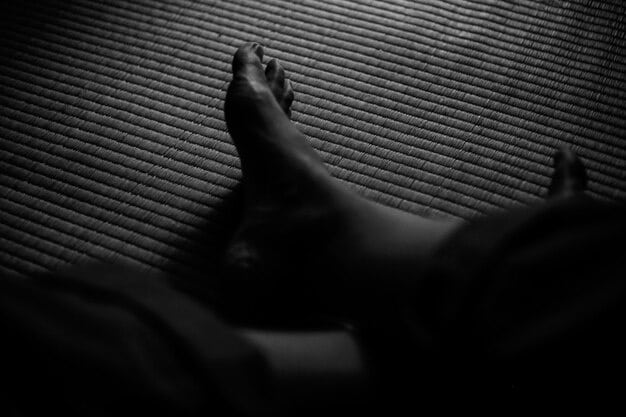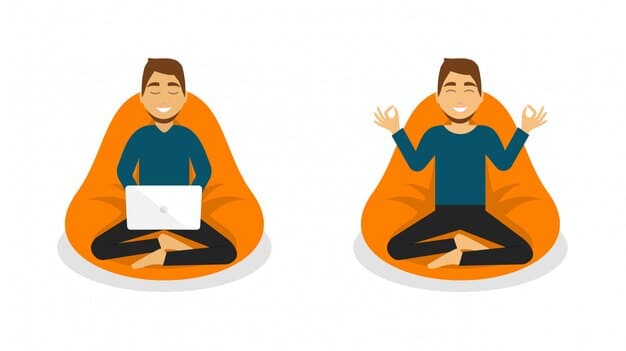Body Scan Meditation: Reduce Anxiety & Increase Awareness in 15 Minutes

Body scan meditation is a powerful technique to reduce anxiety and enhance body awareness. By systematically focusing on different parts of your body, you can release tension and cultivate a deeper connection to your physical self in just 15 minutes.
Feeling stressed or disconnected from your body? Body scan meditation: A step-by-step technique to reduce anxiety and increase body awareness in 15 minutes offers a simple yet effective way to find calm and reconnect with yourself.
What is Body Scan Meditation?
Body scan meditation is a mindfulness technique that involves bringing your attention to different parts of your body, one at a time. It’s a way of noticing sensations, both pleasant and unpleasant, without judgment. This practice can be done anywhere, anytime, and requires no special equipment.
The goal isn’t to change anything or make the sensations go away, but rather to simply observe them with curiosity and acceptance. Through this process, you can become more aware of your body’s signals, release tension, and cultivate a greater sense of presence.
Benefits of Regular Practice
Regular body scan meditation practice offers a multitude of benefits for both your physical and mental well-being. Here are some key advantages:
- Reduced Anxiety: By focusing on the present moment and your body’s sensations, you can interrupt the cycle of anxious thoughts.
- Increased Body Awareness: You’ll become more attuned to the subtle signals your body sends, allowing you to address discomfort or tension before it escalates.
- Improved Sleep: A body scan before bed can help you relax and release any lingering tension, promoting a more restful night’s sleep.
- Stress Management: This meditation helps regulate the nervous system, reducing the physiological effects of stress.
Ultimately, body scan meditation empowers you to develop a more compassionate and accepting relationship with your body, leading to increased self-awareness and emotional well-being.
Preparing for Your 15-Minute Body Scan
Before you begin your body scan meditation, it’s important to create a conducive environment for relaxation and focus. This preparation can significantly enhance the effectiveness of the practice.
Find a quiet and comfortable space where you won’t be disturbed for the next 15 minutes. Minimize distractions and create a soothing atmosphere to fully immerse yourself in the meditation.
Creating a Relaxing Environment
Here are a few tips for setting the stage for your body scan:
- Choose a Quiet Location: Select a room where you can minimize noise and interruptions.
- Dim the Lights: Soft lighting can create a more calming atmosphere.
- Temperature: Ensure the room is at a comfortable temperature.
- Comfortable Clothing: Wear loose, non-restrictive clothing.
These simple steps can help you create an environment that promotes relaxation and allows you to fully focus on the practice.
Step-by-Step Guide to Body Scan Meditation
Ready to begin? This step-by-step guide will walk you through a 15-minute body scan meditation. Remember to approach the practice with patience and kindness towards yourself.
Follow these easy steps to immerse yourself in meditation:
- Lie down on your back on a comfortable surface, or sit in a chair with your feet flat on the floor.
- Close your eyes gently. If closing your eyes feels uncomfortable, you can soften your gaze and look slightly downward.
- Take a few deep breaths, inhaling slowly and exhaling fully. Feel your body relax with each exhale.
- Bring your attention to the toes of your left foot. Notice any sensations you feel – warmth, coolness, tingling, pressure, or nothing at all.
- Gradually move your attention up your left foot, to your ankle, your calf, your knee, and your thigh. Observe any sensations you encounter along the way.
- Once you’ve scanned your entire left leg, shift your attention to the toes of your right foot and repeat the process.
- Continue scanning your body, moving from your legs to your hips, abdomen, chest, back, shoulders, arms, hands, neck, and finally, your head.
- If your mind wanders, gently guide your attention back to the part of your body you were focusing on.
- When you reach the top of your head, take a few more deep breaths and gently wiggle your fingers and toes.
- Slowly open your eyes and take a moment to notice how you feel.

Repeat this practice regularly to experience its full benefits. Remember, there’s no right or wrong way to do it. The key is to be present and attentive to your body’s sensations.
Tips for Staying Focused During Meditation
It’s common for your mind to wander during meditation. Don’t get discouraged if this happens. Staying focused is a skill that develops with practice.
Here are some helpful tips to help you keep your attention on the body scan:
- Acknowledge and Release: When you notice your mind wandering, gently acknowledge the thought and let it go.
- Use Your Breath as an Anchor: If you lose focus, bring your attention back to your breath. The sensation of your breath can serve as a grounding point.
- Be Patient and Kind: Don’t judge yourself for having distracting thoughts. Simply redirect your attention back to the body scan with kindness and patience.
- Practice Regularly: The more you practice, the easier it will become to stay focused.
Dealing with Discomfort
During a body scan meditation, you may encounter uncomfortable sensations. Here’s how to address them:
- Acknowledge the Sensations: Try to observe the discomfort without judgment.
- Breathe Through It: Focus on your breath and breathe deeply into the area where you’re feeling discomfort.
- Adjust Your Position: If the discomfort becomes too intense, gently adjust your position.
Remember, the goal is to observe the sensations without trying to change them. This can help you develop a greater capacity for handling discomfort in your daily life.
Adapting the Body Scan to Your Needs
Body scan meditation is a flexible practice that can be adapted to suit your individual needs and preferences. There is no need to adhere strictly to a rigid format. Feel free to experiment and find what works best for you.
Try a few of these strategies:
- Shorter Sessions: If you don’t have 15 minutes, try a shorter 5 or 10-minute version.
- Focus on Problem Areas: If you have specific areas of tension or pain, spend more time focusing on those areas.
- Guided Meditations: Use a guided meditation app or recording to help you stay focused and navigate the body scan.

By tailoring the practice to your own unique needs, you can maximize its benefits and make it a sustainable part of your self-care routine.
Integrating Body Scan Meditation into Daily Life
Once you’ve become comfortable with the basic body scan meditation, you can start to integrate it into your daily life. This can help you cultivate greater body awareness and mindfulness throughout the day.
Incorporate these practices to make meditation a natural habit:
- Brief Check-Ins: Take a few moments throughout the day to check in with your body. Notice any sensations of tension or discomfort.
- Mindful Movement: Pay attention to the sensations of your body as you move throughout the day, whether you’re walking, stretching, or doing chores.
- Before Bed: Do a body scan before bed to release tension and prepare for a restful night’s sleep.
By incorporating these simple practices, you can cultivate a greater sense of presence and connection with your body, leading to increased well-being and resilience.
| Key Point | Brief Description |
|---|---|
| 🧘 Body Awareness | Enhances awareness of bodily sensations and signals. |
| 😌 Anxiety Reduction | Helps reduce anxiety by focusing on the present moment. |
| 😴 Improved Sleep | Promotes relaxation, leading to a more restful sleep. |
| ⏱️ Quick Practice | Can be done in as little as 15 minutes for immediate benefits. |
Frequently Asked Questions (FAQ)
▼
Falling asleep during a body scan meditation is completely normal, especially if you are tired. Simply acknowledge that you fell asleep and gently bring your attention back to the body and continue where you left off.
▼
Yes, it is perfectly normal to feel nothing at all in certain parts of the body. The goal is not to force sensation but to notice whatever is present, even if that is a lack of sensation.
▼
Yes, body scan meditation can be helpful for chronic pain, but it’s important to approach it with caution and self-compassion. If you experience increased pain, gently shift your attention elsewhere or stop the practice.
▼
The more regularly you practice, the better! Start with a few times a week and gradually increase to daily practice. Even a few minutes a day can make a difference.
▼
While the traditional body scan meditation is done lying down or sitting, you can adapt it to other activities by bringing mindful awareness to your body’s sensations as you move. This is known as mindful movement.
Conclusion
Body scan meditation is a valuable tool for reducing anxiety, increasing body awareness, and cultivating a greater sense of presence. By incorporating this simple technique into your daily routine, you can experience a profound shift in your overall well-being and develop a more compassionate relationship with your body.





